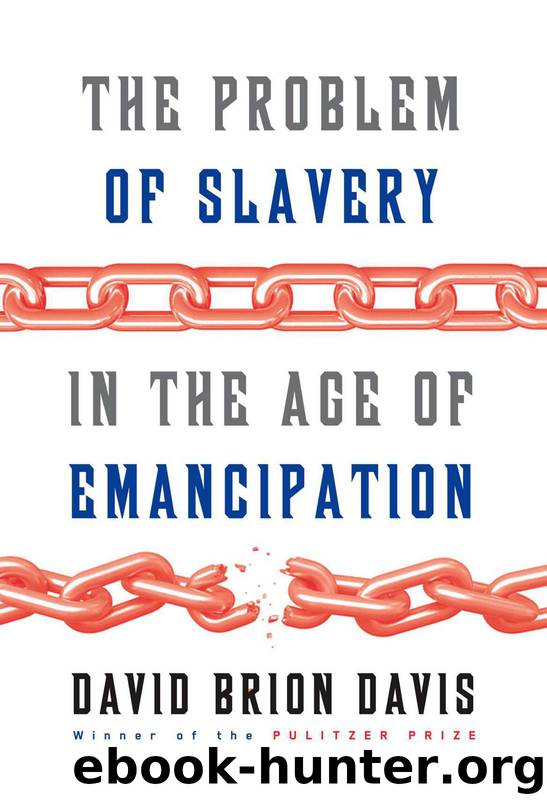The Problem of Slavery in the Age of Emancipation by Davis David Brion

Author:Davis, David Brion [Davis, David Brion]
Language: eng
Format: epub, azw3
ISBN: 9780385351652
Publisher: Knopf Doubleday Publishing Group
Published: 2014-02-03T22:00:00+00:00
THE UNDERGROUND RAILROAD AND RUNAWAY SLAVES
The celebration and romanticizing of the Underground Railroad has at best been a way of publicly recognizing the humanity of slaves and the dehumanizing effects of permanently confining people in times and spaces chosen by masters.
David Blight has noted, in an insightful essay, that despite all that has been learned about slavery in recent decades, the average American is still likely to encounter the subject “first, and most often, through the lore of the Underground Railroad.” Throughout the North, tourists encounter countless “stations” where “conductors” supposedly protected runaway slaves, many on their way to Canada. Cincinnati’s Underground Railroad and Freedom Center has long been one of the nation’s leading centers for learning about slavery. This long history of congratulatory commemoration is deeply embedded in American literature and film—it celebrates one of the few prideful historical moments in racial relations before the civil rights movement.17
In 1872, William Still, the leader of the Philadelphia Vigilance Committee and an active “operator” of the Underground Railroad, published a book on the subject based on extensive interviews and correspondence, as well as on such personal recollections as the arrival of an elderly slave, Daniel Payne, “infirm and well-nigh used up,” who had escaped so that he could “die on free land.” Important scholarly work began in 1892, when Wilbur Sieburt, a historian at Ohio State University, started collecting resources that led to thirty-eight bound volumes, organized by state, as well as the publication of his The Underground Railroad (1898), which included a map of the detailed “routes” slaves took as they entered a supposedly highly rationalized system heading to freedom. Having interviewed former slaves who had escaped, Sieburt offered readers the chance to put themselves in the slaves’ place and did much to create the mythology of the Underground Railroad that has persisted to the present.
David Blight is careful in acknowledging the many revisions historians have brought to the subject, especially since Larry Gara’s landmark study, The Liberty Line: The Legend of the Underground Railroad (1961), while insisting on the need to respect the local lore and mythology as a way of understanding the extraordinary “hold of the Underground Railroad on Americans’ historical imagination.”18
It should be added that the fugitive slave issue was absolutely central in bringing on the Civil War, especially after the North’s hostile response to the Fugitive Slave Law of 1850, with large crowds of Northerners attempting to give aid to captured blacks. The popularity of the Underground Railroad is especially remarkable in view of the widespread fear, popularized by the South, that any significant freeing of slaves would lead to a mass migration to the North, where blacks would take jobs away from the higher-paid whites, especially immigrants. Given the profound depth of Northern racism, it’s clear that many whites who were thrilled over the slaves’ escape would not have wanted runaways settling next door or sending their children to the neighborhood school. But the assumption that most fugitives were headed for Canada helped remove some
Download
The Problem of Slavery in the Age of Emancipation by Davis David Brion.azw3
This site does not store any files on its server. We only index and link to content provided by other sites. Please contact the content providers to delete copyright contents if any and email us, we'll remove relevant links or contents immediately.
| African-American Studies | Asian American Studies |
| Disabled | Ethnic Studies |
| Hispanic American Studies | LGBT |
| Minority Studies | Native American Studies |
Cecilia; Or, Memoirs of an Heiress — Volume 1 by Fanny Burney(32067)
Cecilia; Or, Memoirs of an Heiress — Volume 3 by Fanny Burney(31463)
Cecilia; Or, Memoirs of an Heiress — Volume 2 by Fanny Burney(31412)
The Great Music City by Andrea Baker(30785)
We're Going to Need More Wine by Gabrielle Union(18640)
All the Missing Girls by Megan Miranda(14762)
Pimp by Iceberg Slim(13787)
Bombshells: Glamour Girls of a Lifetime by Sullivan Steve(13691)
Fifty Shades Freed by E L James(12923)
Talking to Strangers by Malcolm Gladwell(12887)
Norse Mythology by Gaiman Neil(12846)
For the Love of Europe by Rick Steves(11543)
Crazy Rich Asians by Kevin Kwan(8894)
Mindhunter: Inside the FBI's Elite Serial Crime Unit by John E. Douglas & Mark Olshaker(8708)
The Lost Art of Listening by Michael P. Nichols(7169)
Enlightenment Now: The Case for Reason, Science, Humanism, and Progress by Steven Pinker(6878)
The Four Agreements by Don Miguel Ruiz(6324)
Bad Blood by John Carreyrou(6283)
Weapons of Math Destruction by Cathy O'Neil(5841)
